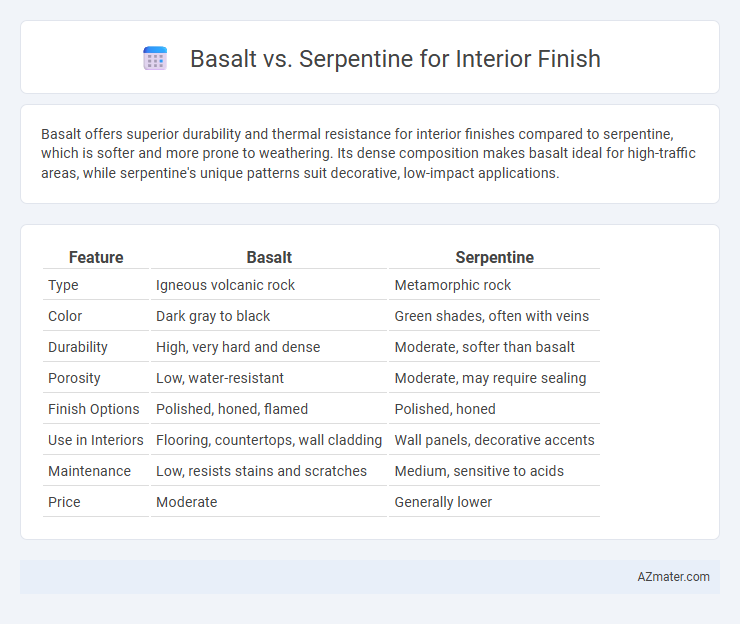Basalt offers superior durability and thermal resistance for interior finishes compared to serpentine, which is softer and more prone to weathering. Its dense composition makes basalt ideal for high-traffic areas, while serpentine's unique patterns suit decorative, low-impact applications.
Table of Comparison
| Feature | Basalt | Serpentine |
|---|---|---|
| Type | Igneous volcanic rock | Metamorphic rock |
| Color | Dark gray to black | Green shades, often with veins |
| Durability | High, very hard and dense | Moderate, softer than basalt |
| Porosity | Low, water-resistant | Moderate, may require sealing |
| Finish Options | Polished, honed, flamed | Polished, honed |
| Use in Interiors | Flooring, countertops, wall cladding | Wall panels, decorative accents |
| Maintenance | Low, resists stains and scratches | Medium, sensitive to acids |
| Price | Moderate | Generally lower |
Introduction to Basalt and Serpentine as Interior Finishes
Basalt is a durable volcanic rock prized for interior finishes due to its hardness, fine grain, and dark, consistent color that adds a sleek, modern aesthetic to spaces. Serpentine, a metamorphic rock with a smooth texture and rich green hues, offers a distinctive and elegant look often used to create luxurious wall cladding and floor tiles. Both materials provide high durability and unique visual appeal, making them popular choices for contemporary interior design projects.
Geological Origins and Characteristics
Basalt, an extrusive igneous rock formed from rapid cooling of basaltic lava, exhibits fine-grained texture and high durability, making it ideal for resilient interior finishes. Serpentine, a metamorphic rock derived from the alteration of ultramafic rocks like peridotite, features a distinctive greenish hue and smooth, often waxy surface, valued for its aesthetic appeal and moderate hardness. The dense hardness and resistance to wear of basalt contrast with serpentine's unique coloration and slight softness, influencing their selection in interior design based on durability versus decorative qualities.
Visual Aesthetics: Color, Texture, and Patterns
Basalt offers a sleek, uniform dark gray to black color palette with fine-grained texture, ideal for modern and minimalist interior finishes. Serpentine displays a vibrant range of greens with variegated, swirling patterns and a smooth, polished surface that enhances visual depth and natural elegance. Both stones provide unique aesthetic qualities, with basalt emphasizing subtle sophistication and serpentine delivering rich, organic visual interest.
Durability and Strength Comparison
Basalt offers superior durability and strength for interior finishes due to its high density and resistance to wear, making it ideal for high-traffic areas. Serpentine, while aesthetically unique with its smooth texture and varied green hues, is comparatively softer and more prone to scratches and weathering. Choosing basalt ensures greater longevity and structural integrity in demanding indoor environments.
Maintenance and Cleaning Requirements
Basalt interior finishes require minimal maintenance due to their dense, non-porous surface, which resists staining and dirt accumulation, making cleaning straightforward with mild detergents and water. Serpentine surfaces are softer and more porous, necessitating frequent sealing to prevent moisture damage and staining, along with careful use of pH-neutral cleaners to avoid surface etching. Basalt's durability and low porosity make it a superior choice for low-maintenance interiors compared to the more sensitive and higher-maintenance serpentine.
Installation Process and Challenges
Basalt tiles offer a dense, durable surface with a relatively straightforward installation process, requiring standard cutting tools and adhesive suitable for natural stone. Serpentine, softer and more prone to chipping, demands careful handling and specialized cutting equipment to prevent damage during installation. Both materials require skilled labor, but serpentine's tendency to absorb moisture and its variable hardness present additional challenges for long-term durability in interior finishes.
Cost Analysis of Basalt vs Serpentine
Basalt offers a cost-effective interior finish option with prices typically ranging from $30 to $50 per square foot, making it more budget-friendly compared to serpentine, which can cost between $45 and $70 per square foot due to its limited availability and complex extraction process. The durability and low maintenance of basalt reduce long-term expenses, while serpentine's unique aesthetic and natural patterns often justify its higher price point in premium projects. Choosing between basalt and serpentine hinges on balancing upfront material costs with design preferences and project budget constraints.
Environmental Impact and Sustainability
Basalt offers superior environmental advantages for interior finishes due to its high durability, low porosity, and natural resistance to wear, reducing the need for frequent replacements and minimizing waste. Serpentine, while aesthetically unique, contains chrysotile asbestos in some varieties, posing potential health risks and complicating sustainable disposal or recycling efforts. Choosing basalt aligns better with eco-friendly building practices by providing a longer lifecycle, lower carbon footprint in production, and safer indoor air quality.
Best Uses and Popular Applications in Interiors
Basalt offers exceptional durability and heat resistance, making it ideal for countertops, flooring, and wall cladding in high-traffic interiors. Serpentine, with its distinctive green hues and smooth texture, is popular for decorative accents, fireplace surrounds, and bathroom vanities where aesthetic appeal is prioritized. Both materials provide unique natural beauty, but basalt excels in structural applications, while serpentine is favored for artistic and softer design features.
Choosing Between Basalt and Serpentine: Key Considerations
Choosing between basalt and serpentine for interior finishes involves evaluating durability, aesthetic appeal, and maintenance needs. Basalt offers exceptional hardness and a sleek, dark appearance suitable for high-traffic areas, while serpentine provides a softer texture with unique green hues ideal for decorative accents. Consider factors such as slip resistance, porosity, and compatibility with indoor humidity levels to ensure long-lasting performance and visual impact.

Infographic: Basalt vs Serpentine for Interior Finish
 azmater.com
azmater.com